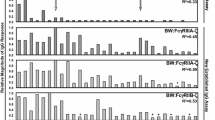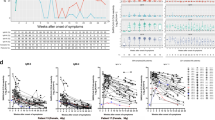Summary
Sixteen patients with symptoms typical for Ockelbo disease (rash, arthralgia, fever) were enrolled in a 2 1/2 year study, during which clinical symptoms were recorded and ELISA was employed to study specific IgM, IgG and IgG subclass development. Initially, all patients presented with rash and arthralgia, and five patients still suffered from joint symptoms at the end of the study period. Ockelbo virus specific IgM was detected during the first week post onset in 6 patients and in 15 patients by day 14. One patient failed to develop specific IgM and was later diagnosed with a human parvovirus B 19 infection. All patients were IgM-negative 2 1/2 years post onset. Seroconversions or significant titer rises for specific total IgG were seen in 15 patients. IgG titers generally peaked within one year but in two patients maximum titers were seen 2 1/2 years post onset. Development of IgG1 followed that of total IgG, while IgG3, after an initial increase in all Ockelbo disease patients, remained at peak levels for one year in four patients, three of whom still had detectable IgG3 at the end of the study period. Ockelbo virus specific IgG2 or IgG4 was not detected in any of the patients.
Similar content being viewed by others
References
Skogh M, Espmark Å (1982) Ockelbo disease: epidemic arthritis-exanthema syndrome in Sweden caused by a Sindbis-virus like agent. Lancet i: 795–796
Lundström JO, Vene S, Espmark Å, Engvall M, Niklasson B (1991) Geographical and temporal distribution of Ockelbo disease in Sweden. Epidemiol Infect 106: 567–574
Brummer-Korvenkontio M, Kuusisto P (1981) Has western Finland been spared the “Pogosta”? Suomen Lääkärilehti 36: 2606–2607
Lvov DK, Skvortsova TM, Kondrashina NG, Vershinsky A, Lesnikov AL, Dereviansky VS, Berezina LK, Gromashevsky VL, Adrianova DP, Yakolev VI (1982) Etiology of Karelian fever — a new arbovirus infection. Vopr Virusol 6: 690–692
Niklasson B, Espmark Å, Le Duc JW, Gargan TP, Ennis WA, Tesh RB, Main AJ (1984) Association of a Sindbis-like virus with Ockelbo disease in Sweden. Am J Trop Med Hyg 33: 1212–1217
Niklasson B (1988) Sindbis and Sindbis-like viruses. In: Monath TP (ed) The arboviruses: epidemiology and ecology. CRC Press, Boca Raton, pp 167–176
Espmark Å, Niklasson B (1984) Ockelbo disease in Sweden: epidemiological, clinical and virological data from the 1982 outbreak. Am J Trop Med Hyg 33: 1203–1211
Niklasson B, Espmark Å, Lundström JO (1988) Occurrence of arthralgia and specific IgM antibodies three to four years after Ockelbo disease. J Infect Dis 157: 832–835
Lowry OH, Rosenbrough NJ, Farr AL, Randall RJ (1951) Protein measurements with the Folin phenol reagent. J Bio Chem 193: 265–275
Wilson MB, Nakane PK (1978) Recent developments in the periodate method of conjugating horseradish peroxidase (HRPO) to antibodies. In: Knapp W, Holubar K, Wick G (eds) Immunofluorescence and related staining techniques. Elsevier/North Holland Biomedical Press, Amsterdam, pp 215–224
Sundqvist V, Wahren B (1981) An interchangeable ELISA for cytomegalovirus antigen and antibody. J Virol Methods 2: 301–312
Calisher CH, Meurman O, Brummer-Korvenkontio M, Halonen PE, Muth DJ (1985) Sensitive enzyme immunoassay for detecting immunoglobulin M antibodies to Sindbis virus and further evidence that Pogosta disease is caused by a Western equine encephalitis complex virus. J Clin Microbiol 22: 566–571
Fridell E (1990) B 19 parvovirus in pregnancy. Scand J Infect Dis [Suppl] 71: 71–72
Linde A, Sundqvist V, Mathiesen T, Wahren B (1988) IgG subclasses to subviral components. Monogr Allergy 23: 27–32
Skvaril F (1986) IgG subclasses in viral infections. Monogr Allergy 19: 134–143
Chantler JK, Ford DK, Tingle DJ (1982) Persistent rubella infection and rubella associated arthritis. Lancet i: 1323–1325
Julkunen I, Brummer-Korvenkontio M, Hautanen A, Kuusisto P, Lindström P, Wager O, Penttinen K (1986) Elevated serum immune complex levels in Pogosta disease, an acute alphavirus infection with rash and arthritis. J Clin Lab Immunol 21: 77–82
Fraser JRE, Ratnamohan VM, Dowling JPG, Becker GJ, Varigos GA (1983) The exanthem of Ross River virus infection: histology, location of virus antigen and nature of inflammatory infiltrate. J Clin Pathol 36: 1256–1263
Author information
Authors and Affiliations
Rights and permissions
About this article
Cite this article
Vene, S., Franzén, C. & Niklasson, B. Development of specific antibody patterns and clinical symptoms following Ockelbo virus infection. Archives of Virology 134, 61–71 (1994). https://doi.org/10.1007/BF01379107
Received:
Accepted:
Issue Date:
DOI: https://doi.org/10.1007/BF01379107




